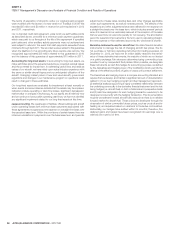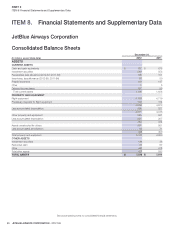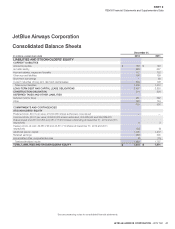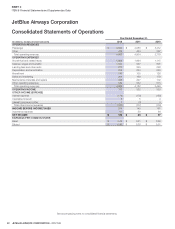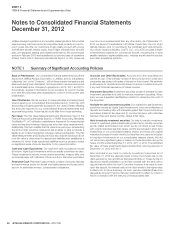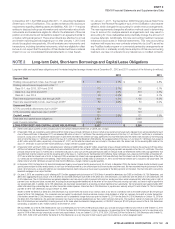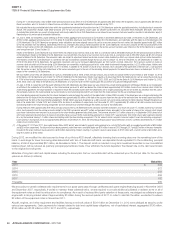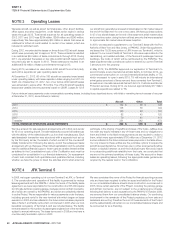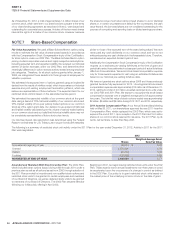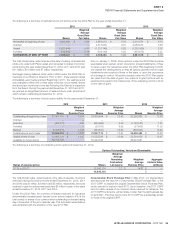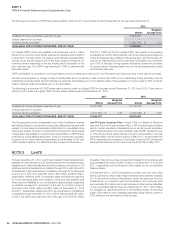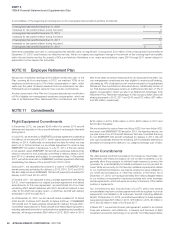JetBlue Airlines 2012 Annual Report Download - page 52
Download and view the complete annual report
Please find page 52 of the 2012 JetBlue Airlines annual report below. You can navigate through the pages in the report by either clicking on the pages listed below, or by using the keyword search tool below to find specific information within the annual report.JETBLUE AIRWAYS CORPORATION-2012 10K48
PART II
ITEM 8Financial Statements and Supplementary Data
Loyalty Program: We account for our customer loyalty program, TrueBlue,
by recording a liability for the estimated incremental cost of providing
transportation for outstanding points earned from JetBlue purchases that
we expect to be redeemed. We adjust this liability, which is included in
air traffi c liability, based on points earned and redeemed, changes in the
estimated incremental costs associated with providing travel and changes
in the TrueBlue program.
Points in TrueBlue are also sold to participating companies, including
credit card and car rental companies. These sales are accounted for
as multiple-element arrangements, with one element representing the
travel that will ultimately be provided when the points are redeemed and
the other consisting of marketing related activities that we conduct with
the participating company. The fair value of the transportation portion of
these point sales is deferred and recognized as passenger revenue when
transportation is provided. The marketing portion, which is the excess of
the total sales proceeds over the estimated fair value of the transportation
to be provided, is recognized in other revenue when the points are sold.
TrueBlue points sold to participating companies which are not
redeemed are recognized as revenue when they expire. We recorded
$5 million, $3 million, and $13 million in revenue related to point expirations
during 2012, 2011 and 2010, respectively.
Our original co-branded credit card agreement, under which we sell
TrueBlue points as described above, provided for a minimum cash
payment guarantee, which was paid to us throughout the life of the
agreement if specifi ed point sales and other ancillary activity payments
were not achieved, and was subject to refund in the event that cash
payments exceeded future minimums through April 2011. We recognized
approximately $10 million and $5 million of other revenue during 2011
and 2010, respectively, related to this guarantee.
Upon the re-launch of the TrueBlue program in November 2009, we
extended our co-branded credit card and membership rewards participation
agreements. In connection with these extensions, we received a one-time
payment of $37 million, which we deferred and are recognizing as other
revenue over the term of the agreement through 2015. We recognized
approximately $7 million, $6 million, and $3 million of revenue related
to this one-time payment during 2012, 2011 and 2010, respectively. In
connection with exclusive benefi ts to be introduced for our co-branded
credit card, we received a one-time payment of $6 million during 2012,
which we have deferred and will recognize as other revenue over the term
of the agreement through 2015. As of December31, 2012, we have not
recorded any revenue related to this one-time payment.
LiveTV Revenues and Expenses: We account for LiveTV’s revenues
and expenses related to the sale of hardware, maintenance of hardware,
and programming services provided as a single unit in accordance with
the Revenue Recognition-Multiple-Element Arrangements topic of the
Codifi cation because we lack objective and reliable evidence of fair
value of the undelivered items. Revenues and expenses related to these
components are recognized ratably over the service periods, which
extend through 2021 as of December31, 2012. Customer advances to
be applied in the next 12 months are included in other current liabilities
on our consolidated balance sheets and those beyond 12 months are
included in other liabilities on our consolidated balance sheets.
Airframe and Engine Maintenance and Repair: Regular airframe
maintenance for owned and leased fl ight equipment is charged to expense
as incurred unless covered by a third-party services contract. We have
separate service agreements covering certain of our scheduled and
unscheduled repair of airframe line replacement unit components and
the engines on our Airbus A320 aircraft. These agreements, which range
from ten to 15 years, require monthly payments at rates based either on
the number of cycles each aircraft was operated during each month or
the number of fl ight hours each engine was operated during each month,
subject to annual escalations. These power by the hour contracts transfer
certain risks, including cost risks, to the third-party service providers and
fi x the amounts we pay per fl ight hour or number of cycles in exchange
for maintenance and repairs under a predefi ned maintenance program,
which are representative of the time and materials that would be consumed.
These payments are expensed as the related fl ight hours or cycles are
incurred. One of our maintenance providers is a subsidiary of a large
shareholder of ours. During 2012, we recorded approximately $7 million
in maintenance expense provided by this related party.
Advertising Costs: Advertising costs, which are included in sales and
marketing, are expensed as incurred. Advertising expense was $57 million
in each of 2012 and 2011, and $55 million in 2010.
Share-Based Compensation: We record compensation expense for
share-based awards based on the grant date fair value of those awards.
Share-based compensation expense includes an estimate for pre-vesting
forfeitures and is recognized over the requisite service periods of the
awards on a straight-line basis, which is generally commensurate with
the vesting term.
Under the Compensation-Stock Compensation topic of the Codifi cation,
the benefi ts associated with tax deductions in excess of recognized
compensation cost are required to be reported as a fi nancing cash fl ow.
We recorded an insignifi cant amount in excess tax benefi ts generated
from option exercises in each of 2012, 2011 and 2010.
Our policy is to issue new shares for purchases under all of our stock
based plans, including our Crewmember Stock Purchase Plan, or CSPP,
and 2011 Crewmember Stock Purchase Plan and issuances under our
Amended and Restated 2002 Stock Incentive Plan, or 2002 Plan, and
our 2011 Incentive Compensation Plan, or 2011 Plan.
Income Taxes: We account for income taxes utilizing the liability method.
Deferred income taxes are recognized for the tax consequences of
temporary differences between the tax and fi nancial statement reporting
bases of assets and liabilities. A valuation allowance for deferred tax assets
is provided unless realizability is judged by us to be more likely than not. Our
policy is to recognize interest and penalties accrued on any unrecognized
tax benefi ts as a component of income tax expense.
New Accounting Standards: Our fi nancial statements are prepared in
accordance with the Codifi cation which was established in 2009 and
superseded all then existing accounting standard documents and has
become the single source of authoritative non-governmental U.S. GAAP.
New accounting rules and disclosure requirements can impact our fi nancial
results and the comparability of our fi nancial statements. Authoritative
literature that has recently been issued which we believe will impact our
consolidated fi nancial statements is described below. There are also several
new proposals under development, including proposals related to leases,
revenue recognition and fi nancial instruments, if and when enacted, may
have a signifi cant impact on our fi nancial statements.
On January 1, 2012, Accounting Standards Update 2011-05, or ASU 2011-
05, amending the Comprehensive Income topic of the Codifi cation, became
effective. This update changes the requirements for the presentation of
other comprehensive income, eliminating the option to present components
of other comprehensive income as part of the statement of changes in
stockholders’ equity, among other things. ASU 2011-05 requires that
all non-owner changes in stockholders’ equity be presented either in a
single continuous statement of comprehensive income or in two separate
but consecutive statements. We have included a separate statement
of comprehensive income in the accompanying consolidated fi nancial
statements for the years ended December31, 2012, 2011 and 2010. In
December 2011, the FASB issued ASU 2011-12, delaying the effective date
of the portion of ASU 2011-05 related to the presentation of reclassifi cation
adjustments out of accumulated other comprehensive income.
On January 1, 2012, ASU 2011-04, which amended the Fair Value
Measurements and Disclosures topic of the Codifi cation, became effective.
The amendments in this update were intended to result in common fair
value measurement and disclosure requirements in U.S. GAAP and
International Financial Reporting Standards, or IFRS. ASU 2011-04
expands and enhances current disclosures about fair value measurements
and clarifi es the FASB’s intent about the application of existing fair value
measurement requirements in certain circumstances. We adopted these
amendments prospectively on January 1, 2012.


